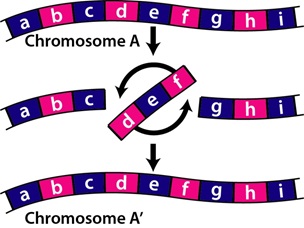What are Mutations
What are Genetic Mutations?
Mutations are changes in the genetic material of an organism. Mutations can cause changes to a single gene (a gene mutation) or initiate changes in the whole chromosome (a chromosomal mutation). Specifically chromosome mutations involve changes to the structure of a chromosome or may involve the loss or gain of a chromosome, while DNA mutations involve a change in the nucleotide-base sequence of a gene on a molecule of DNA.
Mutations can occur in gametes (eggs and sperm) and in somatic cells (cells of the body that are not passed on to offspring). Mutations may be repaired by the body through the action of enzymes or may remain in a cell and affect the way new proteins are synthesized. Although mutations occurring in cells can affect the organism in which they are found, mutations are only passed on to successive generations when they occur in gametes- eggs and sperm. It is estimated that human beings have around 6 mutations in each cell in their body. Very often mutations are not detected and the affected gene can still function. In other instances mutations can be harmful to an organism or even beneficial.
CHROMOSOME MUTATIONS
Chromosome mutations may be simply a change in the structure of chromosomes or genomic mutations where there is a change in the number of chromosomes.
Here we shall look at the main types of chromosome mutations - deletion, insertion, duplication translocation and nondisjunction.
Deletion is the loss of a piece of a chromosome due to the breakage of the chromosome as illustrated below:

The effect of a deletion will depend upon the size and location of the deleted sequence of a genome- the larger the deletion the more genes are likely to be involved. An example of a chromosome deletion is seen in Prader-Willi syndrome, this condition most frequently results from the deletion of the proximal part of chromosome 15. This disease is characterised by developmental delay, an insatiable appetite and physical characteristics such as small hands and feet and being of short stature.
Insertion
Insertion has similar effects to deletion. In chromosome insertion a proportion of a chromosome that has been deleted from its normal position is inserted into another position on the chromosome or onto a non-homologous chromosome.
Inversion
Inversion is a mutation where a piece of a chromosome breaks off, flips around and then reattaches in reverse order, thus inversions change the sequence of a nitrogenous bases on a chromosome. Inversions do not change the genome of an organism but may result in a change in an organism’s phenotype as a result of the ‘positional effect’ of genes on a chromosome.

The most common chromosome inversion in humans involves an inversion on chromosome 9. This inversion has been associated with an increase in infertility and miscarriage.
Duplication
Chromosomal duplications occur when a gene sequence is repeated at some point on a chromosome. Duplications may cause dramatic changes in the phenotype of an organism or may be lethal.
Translocation
Translocation involves two homologous chromosomes and occurs where a piece of a chromosome breaks off and reattaches to the other non-homologous chromosome. The effects of a translocation are therefore, seen on both of the chromosomes involved- the ‘donor’ chromosome suffers a deletion, and the recipient chromosome gains an extra set of genes.
Nondisjunction
Nondisjunction involves the failure of chromosomes to separate during meiosis, causing gametes to have too many or too few chromosomes. Examples include Downs syndrome were there are three 21st chromosomes, Turner’s syndrome where there is a single X chromosome and Klinefelter’s syndrome characterised by XXY chromosomes.
[20/04/2024 21:00:36]